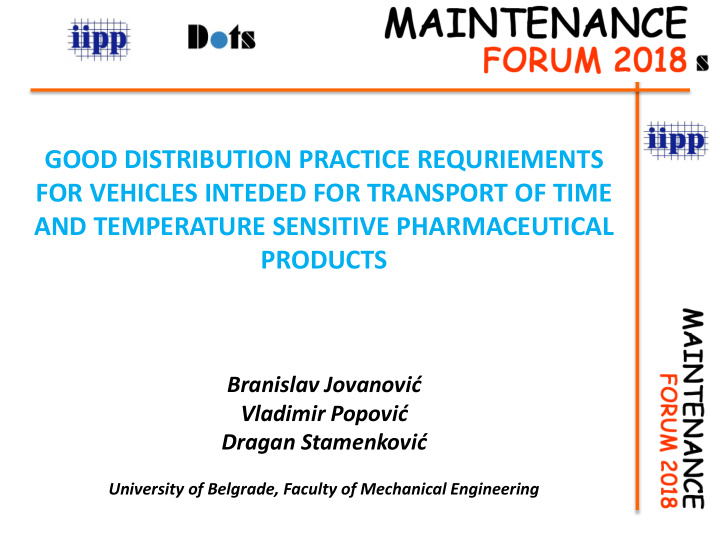



GOOD DISTRIBUTION PRACTICE REQURIEMENTS FOR VEHICLES INTEDED FOR TRANSPORT OF TIME AND TEMPERATURE SENSITIVE PHARMACEUTICAL PRODUCTS Branislav Jova�ović Vladimir Popović Dragan Sta�e�ković University of Belgrade, Faculty of Mechanical Engineering
INTRODUCTION World Health Organization (WHO): • A United Nations specialized agency, coordinates available resources related to international public health • Provides objective and reliable information in the field of human health • Large number of publications (practical handbooks, instructions and various materials are being published for the training) • Progress towards a better health system requires the dissemination and exchange of information on a global level
COLD CHAIN • System of activities that include storage and transport from production to application of the product • The usual transport mode is from +2 ⁰ C, to +8 ⁰ C, depending of the type of the product • Transported products are time and temperature sensitive (TTSPP) • Storage exclusively on a specific temperature prescribed by the manufacturer • Different temperatures and atmospheric conditions may be required from production to application
COLD CHAIN
ATP AGREEMENT • Agreement on the international carriage of perishable foodstuffs and on the special equipment to be used for such carriage • Abbreviation originates: " Accord Relatif Aux Transports Internationaux de Denrées Périssables Et Aux Engins Spéciaux à Utiliser Pour Ces Transports “ • Made in Geneva on September 1st 1970 by the United Nations Economic Commission for Inland Transport for Europe WP.11: • Working party (WP.11) on the transport of perishable foodstuffs was established • Regularly changes and updates the agreement and its annexes • The latest version is dated on January 1st 2018
ATP AGREEMENT Example of refrigerated and insulated equipment:
ATP AGREEMENT K coefficient : • Represents total heating or cooling power by degree of temperature difference - between interior and exterior walls and the surface of the chamber • S i – inner surface of the box • S e – outer surface of the box • T – the difference between the average internal temperature T i and the average external temperature T e • W - heating power or the cooling capacity W S S S 2 K W/m K i e S T
VEHICLE DESIGN • Designed specifically for this purpose in order to ensure the quality of the pharmaceutical product and to prevent contamination • Desirable to install systems for remote tracking of movement of goods and for monitoring atmospheric and temperature conditions that contribute to the safety of the products • Recommendation is that all new vehicles which are designed for transport of pharmaceutical products have a value of K ≤ 0,4 W/m 2 K
CONTROL AND TEMPERATURE MONITORING EQUIPMENT Basic requriements of vehicles that transport TTSPP: • Capable of maintaining the set temperature throughout the whole transport section, regardless if the vehicle is in motion, if it is stationary or the engine is off • Equipped with a system that protects medical cargo from too low temperatures • Cargo bay area equipped with calibrated sensors for temperature and humidity, set at the most unfavorable location • Device for alarming the driver if there is a temperature deviation from the foreseen range • The door of the load compartment is provided with safety markers indicating whether an unauthorized access has occurred
CONTROL AND TEMPERATURE MONITORING EQUIPMENT Basic requirement of equipment that monitors temperature • Sensors for monitoring the temperature with precision of ±5 ⁰ C • Temperature record of the state of each sensor (minimum every 10 min). Basic requirements for humidity monitoring equipment: • Air humidity monitoring sensors with precision ±5% RH • Record of the humidity of each sensor (minimum every 10 min)
QUALIFICATION OF TEMPERATURE- CONTROLLED ROAD VEHICLES Qualification of temperature-controlled road vehicles: • Show that the temperature and humidity of the air in the cargo bay is reflected within the prescribed limits during the planned transport route • Display areas within the cargo bay which should be exempt from direct exposure temperature sources (cold air flow) • In case of failure of the temperature control, the time display of the temperature reach out anticipated working range
CONCLUSION • The goal of the pharmaceutical product suppliers is to provide safe transport from the starting point to the destination point and to deliver products • Transport of these products is time sensitive, especially in emergency situations • If a slightest deviation of the product is noticed, the responsible person should report how the pharmaceutical product was disturbed • Clearly identify the cause of the problem • Resolve and improve all weak spots in cold chain distribution
THANK YOU FOR YOUR ATTENTION!
Recommend
More recommend